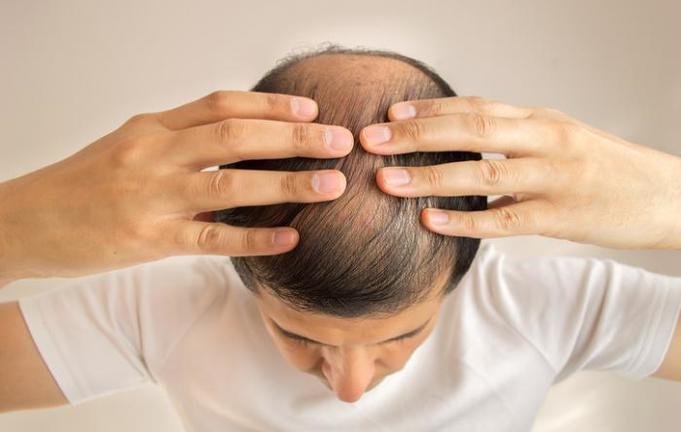Genetic hair loss, also known as male pattern baldness or female pattern hair loss, is a common condition influenced by inherited genes and hormonal factors. Recognizing the early signs of genetic hair loss is crucial for taking proactive measures to minimise its impact or seek appropriate treatments.
Receding Hairline
One of the initial signs of genetic hair loss is a receding hairline, typically starting at the temples and gradually moving back. This distinctive pattern of hair loss can result in a receding hairline that advances faster near the temples, leading to a U-shaped hairline associated with androgenetic alopecia.
Thinning on the Crown
Another common sign of genetic hair loss is thinning on the crown of the head. Bald spots may develop slowly, starting as areas where the hair is noticeably thinner and progressing until significant thinning occurs. Monitoring the crown for signs of thinning can help in early detection of genetic hair loss.
Increased Shedding
Experiencing excessive hair shedding after showering or brushing can be an early warning sign of genetic hair loss. While it’s normal to lose around 50-100 hairs daily as part of the hair growth cycle, an increase in shedding may indicate potential hair loss. Paying attention to the amount of hair shed during daily activities can provide insights into changes in hair health.
Scalp Problems
Issues like an itchy or flaky scalp can be additional risk factors for genetic hair loss. While these problems do not directly cause hair loss, they can contribute to it by affecting the health of the scalp and hair follicles. Managing scalp conditions through appropriate care and treatments can help maintain scalp health and potentially reduce the risk of further hair loss.
Other Indicators
- Photographic Evidence: Comparing photos over time can reveal changes in your hairline or overall hair thickness, aiding in tracking potential signs of genetic hair loss.
- Hair Growth Rate: Changes in how quickly your hair grows or appears thinner can be indicative of underlying issues related to genetic hair loss.
- Barber Observations: Regular visits to your barber can provide valuable insights into changes in your hair thickness, growth patterns, and overall health.
What are the risk factors for genetic hair loss ?
Some of the risk factors for genetic hair loss include:
- Family History: Having a family history of hair loss, especially from parents or siblings, significantly increases the risk of genetic hair loss. Studies have shown that up to 80% of cases of male pattern baldness are hereditary, highlighting the strong influence of genetics on hair loss.
- Genetic Sensitivity to DHT: Genetic hair loss is primarily caused by an inherited sensitivity to dihydrotestosterone (DHT), a hormone that shrinks hair follicles over time. Individuals with a genetic predisposition to DHT sensitivity are more likely to experience hair loss due to the hormone’s effects on hair follicles.
- Age: Most people start experiencing genetic hair loss, also known as male pattern baldness or female pattern hair loss, in their late 20s to early 30s. Around 50% of men will experience noticeable hair loss by the age of 50, highlighting age as a significant risk factor for genetic hair loss.
- Hormonal Factors: Hormonal changes, such as fluctuations in testosterone levels and changes in thyroid hormone levels, can contribute to hair loss. Hormonal imbalances can exacerbate genetic predispositions to hair loss and accelerate the onset of balding patterns.
- Medical Conditions: Certain medical conditions like thyroid disorders, lupus, and autoimmune conditions like alopecia areata can contribute to hair loss. While these conditions may not directly cause genetic hair loss, they can exacerbate existing genetic predispositions and lead to increased hair shedding or thinning.
- Stress: Prolonged periods of physical or mental stress can lead to temporary hair thinning or exacerbate existing genetic hair loss conditions. Stress-related hair loss conditions like telogen effluvium can worsen the impact of genetic factors on hair health.
- Nutritional Deficiencies: Not getting adequate protein or essential nutrients like zinc can negatively impact hair growth and contribute to overall hair health issues. Nutritional deficiencies can exacerbate genetic predispositions to hair loss and affect the quality of hair growth.
Conclusion :
In conclusion, recognising the early signs of genetic hair loss is crucial for proactive management and seeking appropriate treatments. Symptoms such as receding hairline, thinning on the crown, increased shedding, scalp problems, and changes in hair growth rate can indicate genetic predispositions. Additionally, monitoring family history, genetic sensitivity to DHT, age, hormonal factors, medical conditions, stress, and nutritional deficiencies are essential for understanding the risk factors associated with genetic hair loss. Early detection and intervention can significantly mitigate the impact of hair loss and improve overall hair health.
Citations:
[1] https://www.belgraviacentre.com/blog/baldness-the-early-signs-and-prevention
[4] https://www.forhims.co.uk/blog/signs-of-male-pattern-baldness
[5] https://www.hims.com/blog/the-early-signs-of-balding-and-how-to-stop-them
[6] https://www.forhims.co.uk/blog/signs-of-male-pattern-baldness
[7] https://www.hims.com/blog/the-early-signs-of-balding-and-how-to-stop-them




